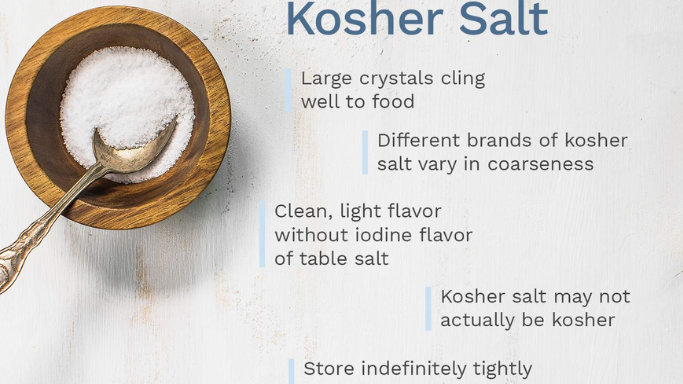Salt is one of the oldest and most essential seasonings in cooking, with many different varieties available in kitchens around the world. Among them, kosher salt is a favorite for chefs and home cooks alike, primarily due to its coarse texture and versatility. But how does kosher salt differ from other types of salt, such as table salt, sea salt, or Himalayan pink salt? The differences lie in texture, taste, processing, and uses, which make kosher salt unique.
Kosher Salt's Texture and Grain Size
The most obvious difference between kosher salt and other salts is its texture. Kosher salt has larger, flakier grains compared to the fine, uniform crystals of table salt or the sometimes irregular crystals of sea salt. The larger grains of kosher salt allow it to dissolve more slowly, which is why it's favored for seasoning and rubbing on meats. Its shape also makes it easier to pinch and sprinkle, providing more control over seasoning.
In contrast, table salt has much smaller, finer grains that dissolve quickly. This makes it a good choice for baking and precise measurements, where consistency is key. The fine texture of table salt, however, can sometimes make it over-powerful when sprinkled directly onto food, requiring more careful application.
Additives and Purity
Another key distinction between kosher salt and table salt is the additives. Table salt is typically refined and includes added iodine, an essential mineral for thyroid health, which was introduced in the early 20th century to prevent iodine deficiency. Table salt also contains anti-caking agents to prevent clumping.
Kosher salt, on the other hand, is usually free of iodine and anti-caking agents, which means it is often considered purer and more natural. Because of this, some people prefer kosher salt for its cleaner taste, especially when it's used as a finishing salt. However, while kosher salt may lack iodine, those who rely on iodized salt for their iodine intake can get it from other sources in their diet.
Processing and Origin
Kosher salt is typically mined from salt deposits or evaporated from seawater, much like other types of salt, but it is usually less refined. The crystals are formed through evaporation, giving kosher salt its characteristic large flakes. Some kosher salts, like Morton’s kosher salt, have a slightly sharper, more angular crystal shape, while others, such as Diamond Crystal, feature softer, lighter flakes.
In contrast, sea salt is harvested from seawater, either by evaporation or mechanical harvesting methods, and can vary widely in texture and taste depending on the source. Sea salt is often less refined than table salt and retains trace minerals like magnesium, calcium, and potassium, which contribute to its distinctive flavor. Himalayan pink salt is a type of rock salt that comes from ancient sea beds in the Himalayas, and it is known for its pink hue, which comes from the presence of iron oxide and other minerals.
Table salt is highly processed, stripped of its natural minerals, and typically treated with bleach to create uniformity and brightness. The added iodine in table salt is an essential nutrient, but the salt’s overall flavor is often considered more metallic or harsh compared to kosher or sea salts.
Uses in Cooking
Kosher salt’s coarse grains make it ideal for seasoning meat in the process known as koshering, which is where the salt gets its name. Its texture makes it easy to apply a thick, even coating to meat, drawing out blood and impurities. This process was historically used in Jewish culinary traditions, but kosher salt’s texture also makes it a go-to for chefs across many cuisines for seasoning meats, vegetables, and dishes where texture is important.
While sea salt and Himalayan pink salt are often used as finishing salts due to their subtle flavors and mineral content, kosher salt is typically used throughout the cooking process, whether for marinating, brining, or sprinkling. Its mild flavor doesn’t overpower the natural taste of the food, making it an excellent choice for seasoning at different stages of preparation.
Kosher salt is also favored for baking over table salt because it has larger crystals and dissolves more slowly. However, it’s important to note that when substituting kosher salt for table salt in recipes, adjustments must be made due to the different crystal sizes. Because kosher salt has larger grains, you would need more of it by volume to achieve the same level of saltiness as table salt.
Why Is Kosher Salt So Popular?
The popularity of kosher salt can be attributed to its versatility, texture, and clean flavor. It is often preferred by chefs for its ease of use when seasoning and the fact that it doesn’t overpower the food. Its ability to dissolve slowly means it can enhance the flavor of meats, vegetables, and even baked goods without being too harsh or overly salty. Many cooks also appreciate the fact that kosher salt is free of additives, making it a more natural option for seasoning food.
Conclusion
Kosher salt is different from other salts in several important ways: its coarse texture, lack of additives, and purity set it apart from fine-grained table salt and the mineral-rich sea salts. Whether it’s for koshering meat, seasoning dishes, or as a finishing touch on meals, kosher salt’s versatility, ease of use, and cleaner taste make it a kitchen staple for both professional chefs and home cooks. However, it’s important to remember that not all salts are interchangeable in cooking, as the size of the grains can significantly affect how much salt you use and how it impacts the flavor.




